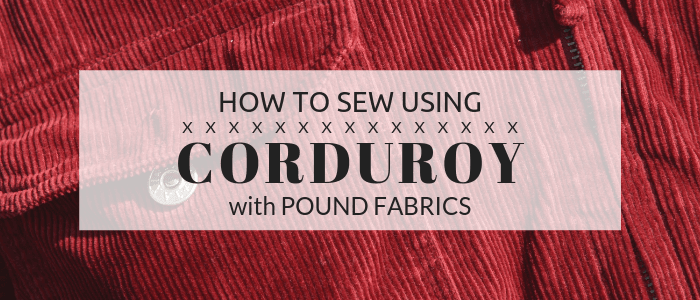Level: Confident Beginner
Corduroy is well known for being difficult to care for and for producing a lot of lint, but with the right treatment and sewing process, this nightmare fabric can sew up a dream, all while producing minimal mess!
Corduroy has many brilliant uses due to its durability, and in this guide, we’ll discuss the best ways to use this fantastic working fabric!
Origins of Corduroy
The origins of Corduroy fabric are often hotly debated by history buffs. The fabric first came into use during the 1700’s in France and Britain, called ‘corde du roi’, translating from French as ‘cord of the king’. Some historians believe that this name originated from the fact that Corduroy was first woven using Silk for royalty, whereas others believe that the name was a clever marketing ploy by British manufacturers who wanted their products to seem more valuable and glamorous!
Regardless of its origins, Corduroy has proved extremely popular over the decades, and from the late 1800’s to the present day is predominantly produced using Cotton. Corduroy is used for a wide variety of items, popular especially for;
- Workwear
- Sportswear
- Hats
- Children’s clothing
- Trousers
- Jackets
- Bags
- Upholstery
- Even some very jazzy car interiors!
Whilst most Corduroy is now imported from around the world, we stock a great supply of quality Corduroy here for different projects. Corduroy is a brilliant fabric for projects that need to be durable, warm and comfortable.
How is Corduroy Made?
Corduroy is generally produced using 100% Cotton, or a Cotton Polyester blend. The pile of the Corduroy is woven, and then cut into a striped pattern, which gives the textile its signature rib design. The ribs are referred to professionally as ‘wales’, and will run the entire length of the fabric.
Wale size can vary dramatically in different styles of corduroy, and range from Featherweight or Mini wales, to Jumbo wales. Wales are generally measured by the number per inch - Featherweight wales, for example, tend to be 22 wales per inch, whereas jumbo wales can stretch to three inches per wale.
How to Sew Corduroy
You Will Need
- Corduroy fabric
- Thread – if you are working with 100% Cotton Corduroy, go for a Cotton thread. If using a Corduroy blend, opt for a Polyester thread.
- Dressmaking scissors
- Sharp straight pins
- Sharps hand sewing needles
- Heavyweight/denim sewing machine needle

Cutting Corduroy
When cutting Corduroy, use sharp dressmaking scissors, or a rotary cutter and mat. You want to ensure your blades are sharp, as Corduroy is notorious for creating a lot of fluff or lint when cutting. A sharp blade will reduce the amount produced, and try to remove this as you go to avoid a machine jam once you begin to sew. You need to bear in mind when cutting that Corduroy has a nap – which is where the hairs and fibres in the fabric don’t lie vertically, effecting the fabrics appearance when positioned various ways. To create a professional-looking item, you will need to ensure that you cut and sew the fabric with the nap all running the same way.
Try to keep your fabric as flat as possible when cutting, and avoid cutting more than a single layer of Corduroy at one time, unless it is lightweight, as this can be incredibly difficult and leave you with an inaccurate cut!
Stitching Corduroy
Corduroy is relatively simple to sew with, if you use the right needle size, and clean up any lint as you go! To sew on a machine, make sure you use a Heavyweight machine needle, or a Denim machine needle. These needles have a thicker, stronger shaft than normal Universal needles, with a sharp point, making it easier to penetrate thicker fabric or multiple thick layers, without breaking.
When hand-sewing or tacking, use regular sharps needles, although you may need a thimble to protect your fingers if the Corduroy is very thick, and sharp straight pins.
Thread selection will vary with the fibre content of your fabric. If you are using a 100% Cotton Corduroy, be sure to use a Cotton thread. For other fibre combinations, especially those with Polyester or a stretch fibre, use a Polyester thread, as this type is a little stronger and less prone to snapping, perfect for stretch fabrics. This will ensure that the fabric and thread share similar properties, making for easier garment aftercare.
You do not need a special sewing machine foot to sew Corduroy, however it can be thick to sew. Try to keep a steady sewing speed, and don’t sew through a seam that is far too thick for your machine to handle. Try to reduce seam bulk as much as possible, and where you can avoid sewing more than 3 layers of Corduroy at once. If you are really struggling, try using a walking foot to keep the layers together.
Stitch length settings on your machine will vary depending on the thickness and wale of your Corduroy, for a lighter-weight Corduroy use a 2mm stitch length, and for anything heavier, use up to 3.5mm. Of course, it is important to always test this on a small sample as it will vary on machine and with every type of Corduroy fabric. Loosening the upper tension and lightening the pressure from the presser foot is also a good idea for an easier sew. Try to hold the fabric taut whilst sewing, and sew in the direction of the nap.
Extra Tips
-
Try Garments with Simple Lines and Shapes –As Corduroy has a lot of surface ‘interest’ and design, it is best to choose a more simplistic pattern or garment to create. This allows the stripe of the wales to be the main feature. Soft, fine-wale Corduroy works best used for dresses, skirts and shirts or blouses. Medium weight Corduroy works best for skirts, jackets, overalls and trousers. Heavy weight or jumbo wale Corduroy is good for coats and outerwear.
-
Consider Nap and Lay-plans -When buying your Corduroy, consider if you require any extra fabric due to the nap. The nap requires directional cutting, so check if your pattern suggests you need extra fabric for directional fabrics or prints, or whether the wale pattern is suitable for your garment.
-
Prewash Your Fabric - If you are intending to create a washable garment, always pre-wash your Corduroy to ensure any shrinkage happens prior to sewing.
-
Only Press with Low Impact -Press your Corduroy fabric as little as possible during its lifetime, both whilst sewing and as a finished garment. Allowing the full weight of your arm or iron to rest on your wales will crush them permanently, as with any napped fabric. Corduroy will become unwrinkled if hung up after washing, and a small amount of steam can be used to finger press and ‘fluff’ up the nap again. To press open a seam while sewing, lay your Corduroy onto a towel on a shaped, not flat, surface, and touch the tip of the iron onto the stitching seam line. Avoid pressing the seam allowance edges flat onto the garment, as this will crush your wales and leave an impression on the right side.
-
Don’t use Fusible Interfacing - This needs to be pressed using heat, and will crush your wales and nap. Instead, use sew-in interfacing.
- Only use Lightweight Facings - This reduces the bulk in the garment overall, making for a better and more comfortable fit. A popular choice is a matching or coordinating fine Cotton fabric.
Finishing Corduroy
Cut edges of Corduroy, and any seam will continue to unravel and fray, if left, with washing and wearing. One way to do this is to overlock the edges or seams, however, many people may not own their own overlocker or serger.
Another option is to finish the seam edge with a ‘Hong Kong finish’. This is where the seam is sewn with bias tape or seam tape to finish, and enclose the raw edge. To create this finish, follow these steps;
- Cut 2.5cm wide bias strips from a lightweight fabric, or use a ready-made seam tape of the same width.
- With right sides together, stitch this binding to the edge of the seam allowance with a 0.6cm seam.
- Wrap the binding around the edge and press. Ditch-stitch to secure.
To hem your fabric, you can use a regular turned-up hem, topstitched in place. Sometimes the Corduroy may not show topstitching well, as the nap can hide it in certain places. To get your topstitching to show up, you can use a special topstitching thread, which is a little thicker, or a double strand of regular thread, and a longer stitch length, of about 3.5-4mm.
If you don’t want visible topstitching, you can also use an invisible hem. Finish the raw edge of your Corduroy using an overlocker, or a simple zig-zag stitch, then sew the hem by hand using a blind-hemming stitch. The stitches hold the hem in place, without making an impression on the right side, so are not visible.
Corduroy has remained popular over the years for good reason, and chances are that you’re going to come across it for years to come! So, it’s time to start using it in your own projects. Have you used corduroy before? Or do you have any favourite uses for it? Comment below to let us know!
Take a look at our corduroy fabric here.











Gwen lenton
January 14, 2025
Thank you for the tips on how to work with corduroy . I have worked with corduroy before but not for some time . Last about 10 years ago when l
Reupholstered a modular lounge lounge suite for my son and it was amazing thick wale but the weave was on a loose backing which made it very easy to stitch .
Now my son has asked me to make him a lined sports jacket which I think is next level , so I thought I’d do some research to get some tips and hacks to Produce a professionally made jacket.